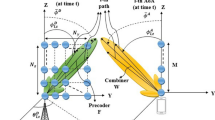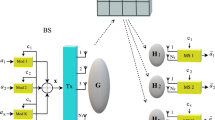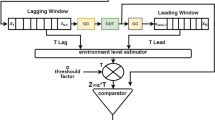Abstract
Based on the sum and difference coarrays, multiple-input multiple-output (MIMO) radar with minimum redundancy (MR) concept, referred to as MR MIMO, can considerably increase the spatial degrees of freedom (DOFs). However, traditional MR MIMO needs computational search to determine the position of each element. In this paper, a modified MR monostatic MIMO configuration is proposed, referred to as MMRM MIMO. In the proposed system, the MMRM MIMO radar is consisted of several levels of uniform linear array, which brings the advantage that the position of each element can be determined without computational search. Furthermore, it offers more than \(N^{2}\) DOFs for an N-elemental array. In order to utilize the extended DOFs of MMRM MIMO radar for direction-of-arrival (DOA) estimation, an average Toeplitz approximation method (TAM) is employed, which achieves robust performance even under low signal-to-noise ratio, few snapshots and array error. Numerous simulation results are provided to demonstrate the effectiveness of the proposed method for DOA estimation.









Similar content being viewed by others
References
Abramovich, Y. I., Spencer, N. K., & Gorokhov, A. Y. (1999). Positive-definite Toeplitz completion in DOA estimation for nonuniform linear antenna arrays. II. Partially augmentable arrays. IEEE Transactions on Signal Processing, 47, 1502–1521.
Abramovich, Y. I., Spencer, N. K., Gorokhov, A. Y., & Spencer, N. K. (1998). Positive-definite Toeplitz completion in DOA estimation for nonuniform linear antenna arrays. I. Fully augmentable arrays. IEEE Transactions on Signal Processing, 46, 2458–2471.
Ali, T., Sadeque, A., Saquib, M., & Ali, M. (2014). MIMO radar for target detection and localization in sensor networks. IEEE Transactions on Signal Processing, 8(1), 75–82.
Bekkerman, I., & Tabrikian, J. (2006). Target detection and localization using MIMO radars and sonars. IEEE Transactions on Signal Processing, 54, 3873–3883.
Cao, Y., Zhang, Z., Dai, F., & Xie, R. (2011). Direction of arrival estimation for monostatic multiple-input multiple output radar with arbitrary array structures. IEEE Transactions on Signal Processing, 6, 679–686.
Chen, C. Y., & Vaidyanathan, P. P. (2008). Minimum redundancy MIMO radars. In Proceedings of the IEEE international symposium on circuits systems (ISCAS), 2008, May 18–21, 2008, pp. 45–48.
Frankford, M., Stewart, K., Majurec, N., & Johnson, J. (2014). Numerical and experimental studies of target detection with MIMO radar. IEEE Transactions on Signal Processing, 50(2), 1569–1577.
Gu, C., He, J., Zhu, X., & Liu, Z. (2010). Efficient 2D DOA estimation of coherent signals in spatially correlated noise using electromagnetic vector sensors. IEEE Transactions on Signal Processing, 21, 239–254.
Hack, D., Patton, L., Himed, B., & Saville, M. (2014). Detection in Passive MIMO Radar Networks. IEEE Transactions on Signal Processing, 62(11), 2999–3012.
Haupt, R. L. Interleaving thinned sum and difference linear arrays. In Antennas and propagation society international symposium 2006, IEEE, 2006, pp. 4773–4776.
Hoctor, R. T., & Kassam, S. A. (1990). The unifying role of the coarray in aperture synthesis for coherent and incoherent and imaging. Proceedings of the IEEE, 78, 735–752.
Li, J., & Stoica, P. (2007). MIMO radar with colocated antennas. IEEE Signal Processing Magazine, 24, 106–114.
Liu, C. L., & Vaidyanathan, P. P. (2015). Remarks on the spatial smoothing step in coarray MUSIC. IEEE Transactions on Signal Processing, 22(9), 1438–1442.
Ma, W. K., Hsieh, T. H., & Chi, C. Y. (2009, April). DOA estimation of quasi-stationary signals via Khatri-Rao subspace. In Proceedings of the international conference on acoustics, speech signal processing (ICASSP), pp. 2165–2168.
Pal, P., & Vaidyanathan, P. P. (2010). Nested arrays: A novel approach to array processing with enhanced degrees of freedom. IEEE Transactions on Signal Processing, 58(8), 4167–4181.
Pal, P., & Vaidyanathan, P. (2012a). Nested arrays in two dimensions, part II: Application in two dimensional array processing. IEEE Transactions on Signal Processing, 60(9), 4706–4718.
Pal, P., & Vaidyanathan, P. (2012b). Nested arrays in two dimensions, part I: Geometrical considerations. IEEE Transactions on Signal Processing, 60(9), 4694–4705.
Pal, P., & Vaidyanathan, P. P. (2014a). Gridless methods for underdetermined source estimation. In Proceedings of the IEEE asilomar conference on signals, systems, and computers, 2014.
Pal, P., & Vaidyanathan, P. (2014b). A grid-less approach to underdetermined direction of arrival estimation via low rank matrix denoising. IEEE Signal Processing Letters, 21(6), 737–741.
Piliai, S. U., & Kwon, B. H. (1989). Forward/backward spatial smoothing techniques for coherent signal identification. IEEE Transactions on Antennas and Propagation, 37, 8–15.
Ruf, C. S. (1993). Numerical annealing of low-redundancy linear arrays. IEEE Transactions on Antennas and Propagation, 41, 85–90.
Shnidman, D. A. (2004). An optimization technique for sum and difference array factors Aerospace and Electronic Systems. IEEE Signal Processing Letters, 40(1), 360–370.
Sun, X., Zhou, J., & Chen, H. (2014). Low complexity direction-of-arrival estimation of coherent noncircular sources. Multidimensional Systems and Signal Processing, 27(1), 159–177.
Suwandi, L., Leyman, A., & Yong, H. (2006). Fourth-order and weighted mixed order direction-of-arrival estimators. IEEE Signal Processing Letters, 13(11), 691–694.
Tan, Z., Eldar, Y., & Nehorai, A. (2014). Direction of arrival estimation using co-prime arrays: A super resolution viewpoint. IEEE Transactions on Signal Processing, 61(21), 5565–5576.
Tan, Z., & Nehorai, A. (2014). Sparse direction of arrival estimation using co-prime arrays with off-grid targets. IEEE Signal Processing Letters, 21(1), 26–29.
Thakrc, A., Haardt, M., & Giridhar, K. (2009). Single snapshot spatial smoothing with improved effective array aperture. IEEE Signal Processing Letters, 15(6), 505–508.
Zhang, Y., Amin, M., & Himed, B. (2013, May). Sparsity-based DOA estimation using co-prime arrays. In Proceedings of the IEEE international conference on acoustics, speech, signal processing, pp. 3967–3971.
Zhang, X., Chen, C., Li, J., & Xu, D. (2014a). Blind DOA and polarization estimation for polarization-sensitive array using dimension reduction MUSIC. IEEE Transactions on Signal Processing, 25, 67–82.
Zhang, Y., Qin, S., & Amin, M. (2014b, May). DOA estimation exploiting coprime arrays with sparse sensor spacing. In Proceedings of the IEEE international conference on acoustics, speech, signal processing, pp. 2267–2271.
Zhang, X., Zhou, M., Chen, H., & Li, J. (2014c). Two-dimensional DOA estimation for acoustic vector-sensor array using a successive MUSIC. IEEE Transactions on Signal Processing, 25, 583–600.
Zheng, G., & Chen, B. (2015). Unitary dual-resolution ESPRIT for joint DOD and DOA estimation in bistatic MIMO radar. IEEE Transactions on Signal Processing, 26, 159–178.
Author information
Authors and Affiliations
Corresponding author
Additional information
This study has been supported by the National Natural Science Foundation of China under contract No. 61271292 and No. 61431016 and the Fundamental Research Funds for the Central Universities.
Appendices
Appendix 1
Proof of Corollary 1
From (15), the last sensor location in MMRA is
where \(N_{\mathrm{A}} =N_1 +N_2 \) is fixed.
(i) \(N_{\mathrm{A}} =N_1 +N_2 \) is even:
If \(N_1 =N_2 \), the last sensor location in MMRA with \(N_{\mathrm{A}} \) being even is
Hold \(N_{\mathrm{A}} \) invariant, then change the number of sensors in first level and second level of Part I as \({N}'_{E,1} =N_1 -n\) and \({N}'_{E,2} =N_1 +n\) respectively, where \(0<n<N_1 \). Then (26) can be rewritten as
Similarly hold \(N_{\mathrm{A}} \) invariant, then change the number of sensors in first level and second level of Part I as \({N}''_{E,1} =N_1 +n\) and \({N}''_{E,2} =N_1 -n\) respectively, where \(0<n<N_1 \), then it can be obtained that
In conclusion, if \(N_{\mathrm{A}} =N_1 +N_2 \) is even, the MMRA will extend the maximum degree of freedom when \(N_1 =N_2 \).
(ii) \(N_{\mathrm{A}} =N_1 +N_2 \) is odd:
If \(N_2 =N_1 +1\), the last sensor location in MMRA with \(N_{\mathrm{A}}\) being odd is
Hold \(N_{\mathrm{A}} \) invariant, then change the number of sensors in first level and second level of Part I as \({N}'_{O,1} =N_1 -n\) and \({N}'_{O,2} =N_1 +1+n\) respectively, where \(0<n<N_1 \), then (24) can be rewritten as
Similarly hold \(N_{\mathrm{A}} \) invariant, then change the number of sensors in first level and second level of Part I as \({N}''_{O,1} =N_1 +n\) and \({N}''_{O,2} =N_1 +1-n\) respectively, where \(0<n<N_1 +1\), then it is obvious that
Therefore if \(N_{\mathrm{A}} =N_1 +N_2 \) is odd, the MMRA will enhance the maximum degree of freedom when \(N_2 =N_1 +1\). \(\square \)
Appendix 2
Proof of Corollary 2
According to Corollary 1, if \(N_{\mathrm{A}} =N_1 +N_2 \) is even, the MMRA can extend the most DOFs when \(N_1 =N_2 \). Assume that\(N_{\mathrm{A}}\) is even and the number of sensors in each level of Part I is \(N_1 \), then the number of sensors in Part II is
Insert (31) into (25), then the last sensor location in MMRA is
Based on Corollary 1, if the number of sensors in Part I is \(N_{\mathrm{A}} +1\) and \(N_1 \) is fixed, then \({N}'_2 =N_1 +1\). So keep N fixed and the number of sensors in Part II is
Insert (33) into (28), then the last sensor location in MMRA is
Then the difference between (36) and (34) is
Insert the known condition into (35), which leads to
Next, if the number of sensors in Part I is \(N_{\mathrm{A}} +2\) and \({N}'_2 \) is fixed, then \({N}''_1 =N_1 +1\). Hence N is fixed and the number of sensors in Part II is
Insert (37) into (25), the last sensor location in MMRA is
Then the difference between (38) and (34) is
Insert the known condition into (39), which can be rewritten as
As observed in Sect. 3, the more \(N_1 \) is, the longer spacing between sensors in Part II is. Compared (36) to (40), we can obtain the conclusion: if \(N=3N_1 -1\) or \(3N_1 \), then \(N_{\mathrm{A}} =2N_1 \) and \(N_3 =N_1 -1\) or \(N_1 \); if \(N=3N_1 +1\), then \(N_{\mathrm{A}} =2N_1 +1\) and \(N_3 =N_1 \). \(\square \)
Rights and permissions
About this article
Cite this article
Huang, Y., Liao, G., Li, J. et al. Sum and difference coarray based MIMO radar array optimization with its application for DOA estimation. Multidim Syst Sign Process 28, 1183–1202 (2017). https://doi.org/10.1007/s11045-016-0387-2
Received:
Revised:
Accepted:
Published:
Issue Date:
DOI: https://doi.org/10.1007/s11045-016-0387-2




